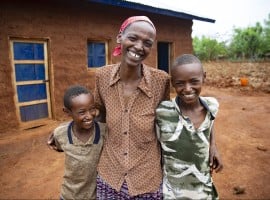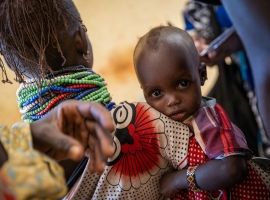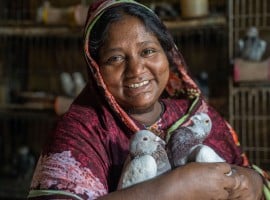
Read our 2024 annual report

Knowledge Hub
In the last year, famine has been confirmed in both Sudan and Gaza. Here's what you need to know.
Recently, the Integrated Food Security Phase Classification officially declared famine in Gaza. The report confirms famine in Gaza Governorate, and added that this threshold could be crossed in the nearby Deir al-Balah and Khan Younis Governorates by the end of this month.
The deteriorating humanitarian situation in Gaza has been closely monitored for nearly two years, so why is it only now that famine has been confirmed? And what does that word actually mean?
“Famine” gets used a lot as a word. In the world of humanitarian aid, it has a specific meaning and use cases. Here, we go into what a famine is, when it’s declared, how it’s measured — and why one word can’t give us the whole story of our global hunger crisis.
What is a famine?
Famines take place when a substantial percentage of a country, territory, or region’s population are unable to get sufficient food. It represents the highest-possible levels of hunger and malnutrition in an area.
Without adequate food and nutrition security, the effects of hunger begin to accumulate, leading to high levels of acute malnutrition, other disease outbreaks facilitated by weakened immune systems, and death.
When is a famine declared? And who declares it?
There are three criteria that determine a famine:
- 20% of a population are suffering extreme food shortages
- 30% of children under the age of 5 are suffering acute malnutrition
- The death rate of an area has doubled, or two people (or four children) out of every 10,000 people die each day
Famine can be declared across a country or either local or international regions.
It’s up to individual governments to declare the beginning (and the end) of a famine. This can be especially difficult in many of the world’s hungriest countries — aka, the countries most likely to experience a famine — since these are also areas where there is often a lack of infrastructure. Governments often don’t have the resources to track food shortages, child malnutrition, or fatality rates.
Another organisation that helps out with this monitoring is one we mentioned above: the Integrated Food Security Phase Classification (IPC). This initiative, designed by the UN and comprising 21 global partners (including NGOs and inter-governmental organisations) measures food insecurity levels around the world.
The IPC tracks hunger levels on a five-phase scale ranging from minimal food insecurity to catastrophic levels of hunger. You may hear about people in a food crisis being classified as IPC Phase 3 or IPC Phase 5. Phase 5 is famine, or famine-like conditions.
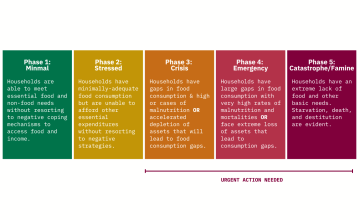
What causes famine?
Many of the same causes of hunger also contribute to a famine. The World Food Programme lists five in particular:
- High food prices
- Natural disasters
- Climate change
- Lack of humanitarian access
- Conflict
Looking at the above, you may notice that some of these causes are connected. These intersectionalities are one of the biggest reasons that a hunger crisis becomes a famine.
In these situations, there is never an easy fix. The WFP also points out that these causes of famine (unlike some causes of hunger) are largely man-made, meaning that we can control the outcomes at a high-enough level. But this often requires international diplomacy, cooperation, and compromise.
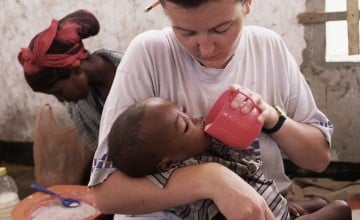
What famines are happening today?
The famine in Gaza is the latest to be confirmed, with 640,000 people expected to face catastrophic levels of hunger between now and the end of September. (That’s roughly 32% of the population of the Gaza strip.) The IPC also estimates that 132,000 children under the age of five are under threat between now and next June.
Last year, famine was also confirmed in parts of Sudan, as a result of the country’s ongoing conflict. The IPC’s Famine Review Committee reported on five areas experiencing the conditions already and projected that five additional areas would cross the threshold by the first half of 2025, leaving half of the country’s population (24.6 million people) facing high levels of acute food insecurity.
In the last 15 years, three other famines have been confirmed: Somalia in 2011, and South Sudan in both 2017 and 2020.
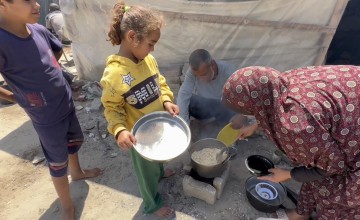
What are the effects of famine?
Famine is more than just hunger. Its effects are further reaching, and last long after it’s over. People who die during a famine often don’t die from starvation. They die from diseases that take advantage of their immune system’s vulnerability after it’s weakened by malnutrition.
Survivors are also likely to have long-term effects as well, including hypertension, type-2 diabetes, and mental health effects. Children who survive a famine are at especially high risk for stunting, which impacts body and brain development. Stunting often leaves children vulnerable to a lifetime of health issues as well as lower intellectual attainment.
The health effects of famine can also carry on for generations, especially as malnutrition affects maternal and child health. Recent research conducted at UC Berkeley’s School of Public Health showed that the Great Chinese Famine of 1959-61 has led to intergenerational transmissions of tuberculosis still traceable today.
This can have a serious knock-on effect: Studies have shown that children who are stunted are four times as likely to die than their non-stunted peers. If they survive to adulthood, they’re more likely to be caught in the cycle of poverty, earning 22% less than their peers.
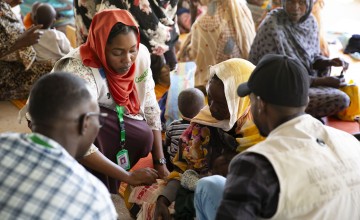
Does it matter what we call it?
Declaring a famine isn’t something done lightly. As noted above, Gaza is only the fifth confirmed in 15 years. However, it can open up channels to more funding and provide the impetus for governments and various sectors to work together to eliminate the barriers to delivering emergency food assistance and other causes of the famine in question.
That said, declaring a famine is the last available recourse to a hunger crisis that can have been developing for months, if not years. Organisations like the IPC raise these issues long before communities reach catastrophic levels.
Even before people reach IPC Level 5, they still face impossible situations as they try to feed themselves and their families enough to make it through each day. We need to do more to prevent hunger crises before they start.
How can we prevent famine?
Famine response is often an expensive and involved process, including multisector support to restore communities on several fronts (livelihoods, health, nutrition, infrastructure), political action in the case of conflict-related famine, and humanitarian funding and access.
But the most effective strategy for famine response is prevention, which we do most effectively through early warning and early action (EWEA) systems.
Early warning saved Somalia from another famine in 2017. During the 2011-12 famine in the country, precious lead time was lost while organisations waited to understand the full picture of need and risks. EWEA was developed in response to that loss, and formed the foundation of Concern’s Building Resilient Communities in Somalia project (BRCiS).

Instead of responding to the emergency based on 100% certainty, we began to respond based on the probability of a disaster. This follows the adage that an ounce of prevention is worth a pound of cure.
We put this system into action in 2016, when there were early signs that rains in Somalia would fail the following season. BRCiS team members began providing additional monthly cash transfers to the most vulnerable families in the region. When the rains in 2017 did indeed fail, we increased the cash transfers by 30% and expanded them to twice the number of families, and continued this into 2018.
The rains failed, and crops along with them. However, markets continued to function and food remained available for purchase. No famine was declared in Somalia that year.
Ending hunger and famine: Concern’s response
The majority of people Concern works with are involved in some way with farming and food production. Many of these communities are also on the frontlines of climate change. We work with rural communities to promote Climate Smart Agriculture, an approach that helps families adapt to better crops, growing techniques, and soil improvement practices in response to the changing - and often unpredictable - environment. We also work to strengthen links with the private sector to facilitate access to supplies and equipment.
We combine this with our award-winning and standard-setting programme, Community Management of Acute Malnutrition (CMAM), which has saved millions of lives over the past 20 years. We’ve continued to work with partners and communities to find more tailored approaches to community-based treatment of childhood malnutrition, which has led to CMAM Surge: a way of proactively responding to malnutrition during seasonal “surge” periods throughout the year. Two CMAM Surge pilot tests in Kenya in 2012 saw that the model managed peaks, without undermining other health and nutrition efforts.
Supporting Concern means that 88c of every euro donated goes to our life-saving work in 26 countries around the world. Last year, we were able to reach over 11.4 million people with our health and nutrition initiatives.
Our impact in 2024
people reached through our emergency response
people reached through our health interventions
people reached through our livelihoods programmes
